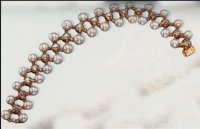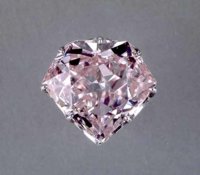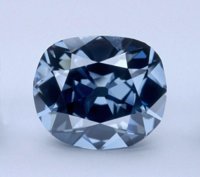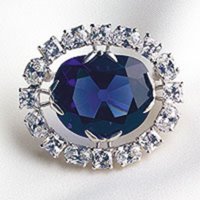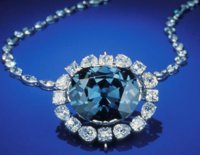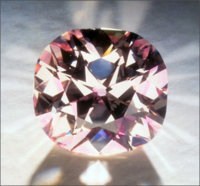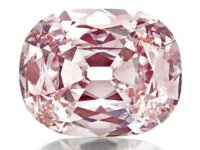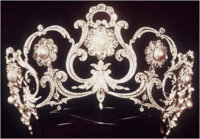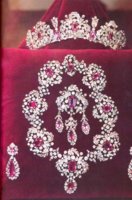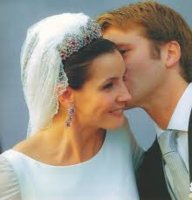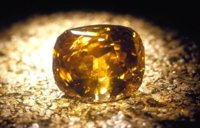You are using an out of date browser. It may not display this or other websites correctly.
You should upgrade or use an alternative browser.
You should upgrade or use an alternative browser.
Royalty & their Jewelry
- Thread starter Japster
- Start date
TPF may earn a commission from merchant affiliate
links, including eBay, Amazon, and others
More options
Who Replied?The Hortensia Diamond Part of French Crown Jewels
King Louis XIV was respsonsible for the addition of this pale orangey-pink diamond to the Crown Jewels of France. The Hortensia was the foremost diamond in the third of the nineteen florets of buttonholes listed in the inventory of the Crown Jewels of France, made in 1691.
The diamond which weighs 20 carats is pale orangey pink, rather flat and rectangular in shape and is cut on five sides. In the 1791 inventory of the Crown Jewels it was valued at no more than 48,000 livres on account of a crack extending from the edge of the girdle to near the culet. It takes its name from Hortense de Beauharnais, Queen of Holland, undoubtedly because she wore it. Hortense was the daughter of the Empress Josephine, the step daughter of Napoleon Bonaparte and the mother of Napoleon III.
The Hortensia was among the jewels stolen from the Garde Meuble in September of 1792. One year later it was recovered from the attic of an old house in the Halles district of Paris. The Regent Diamond was with it as were a number of other jewels. As he was about to be executed a man named Depeyron disclosed that he had hidden it in a bag containing gold and other diamonds including the Regent and where they were hidden.
During the First Empire the Hortensia was mounted on the fastening of Napoleon's epaulette braid. Later it was set in the center of the headband of the great diamond encrusted comb made by the Court Jeweler Bapst, for Empress Eugénie in 1856. In between, in 1830 the diamond was stolen again on this occasion from the Ministry of the Marine but it was quickly recovered.
When the French Crown Jewels were sold in 1887 the Hortensia was one of the items excluded along with the Regent, because of their historic and artistic interest. The Sancy Diamond wouldn't join them in the Louvre until a little less than a century later.
King Louis XIV was respsonsible for the addition of this pale orangey-pink diamond to the Crown Jewels of France. The Hortensia was the foremost diamond in the third of the nineteen florets of buttonholes listed in the inventory of the Crown Jewels of France, made in 1691.
The diamond which weighs 20 carats is pale orangey pink, rather flat and rectangular in shape and is cut on five sides. In the 1791 inventory of the Crown Jewels it was valued at no more than 48,000 livres on account of a crack extending from the edge of the girdle to near the culet. It takes its name from Hortense de Beauharnais, Queen of Holland, undoubtedly because she wore it. Hortense was the daughter of the Empress Josephine, the step daughter of Napoleon Bonaparte and the mother of Napoleon III.
The Hortensia was among the jewels stolen from the Garde Meuble in September of 1792. One year later it was recovered from the attic of an old house in the Halles district of Paris. The Regent Diamond was with it as were a number of other jewels. As he was about to be executed a man named Depeyron disclosed that he had hidden it in a bag containing gold and other diamonds including the Regent and where they were hidden.
During the First Empire the Hortensia was mounted on the fastening of Napoleon's epaulette braid. Later it was set in the center of the headband of the great diamond encrusted comb made by the Court Jeweler Bapst, for Empress Eugénie in 1856. In between, in 1830 the diamond was stolen again on this occasion from the Ministry of the Marine but it was quickly recovered.
When the French Crown Jewels were sold in 1887 the Hortensia was one of the items excluded along with the Regent, because of their historic and artistic interest. The Sancy Diamond wouldn't join them in the Louvre until a little less than a century later.
Attachments
Hope Diamond once part of French Crown Jewels
The most famous diamond in the world.The Hope originated from India in Golconda where it was mined at the at the Kollur mine. The famous Hope diamond was first known as the "French Blue" or the "Tavernier Blue" as it was acquired by Jean-Baptiste Tavernier the French traveller and pioneer of jewelry and diamond trade with India. The French Blue was then passed from one ruling French King to the next until the French Revolution when it was stolen. What happened next was a bit of a mystery but in 1839 an entry of a fabulous blue diamond was entered in the gem collection catalog of Henry Philip Hope the man from whom the diamond now takes its name. The gem catalog did not reveal where or from who Henry Philip Hope acquired the diamond or how much he paid for it. It was said that "Bad luck and death not only for the owner of the diamond but for all who touched it." Possession of the Hope diamond led to violent deaths, disaster and debt leading to stories, myths and legends of the Curse of the Hope Diamond.The Curse of the Hope Diamond
The Curse of Hope Diamond dates back to its Indian heritage. The great blue diamond was said to have been stolen from the Forehead of an Idol. The Curse of the Hope Diamond foretells :
"Bad luck and death not only for the owner of the diamond but for all who touched it. "
The legend does not state who stole the diamond but it was definitely acquired by Jean-Baptiste Tavernier who first took the diamond from India to Europe.
The curse of the Hope Diamond is said to have first inflicted a terrible death on Tavernier who died of a fever and whose body was then torn apart by wolves
The diamond was sold to King Louis XIV of France. Louis XIV died on September 1, 1715 of gangrene but almost all of his legitimate children and grandchildren died. His five-year-old great-grandson succeeded him to reign as Louis XV of France
Louis XV was a weak and dissolute King. One of his mistresses was the Comtesse Du Barry who was beheaded during the French Revolution
The next King was Louis XVI. Both he and his wife Marie Antoinette were beheaded during the French Revolution
The diamond passed to the English King George IV who left considerable debts
The Hope Family ended up selling the diamond because of debts
The American Evalyn Walsh McLean owned the Hope Diamond and her life was best by tragedies and after her death the Hope Diamond once again had to be sold to settle debts
The Hope Diamond is currently housed in the Smithsonian Natural History Museum in the USA. The lives and the greed of many of the owners and wearers of the produced many stories of ill-luck that plagued them and became part of the history of the Hope diamond.
The most famous diamond in the world.The Hope originated from India in Golconda where it was mined at the at the Kollur mine. The famous Hope diamond was first known as the "French Blue" or the "Tavernier Blue" as it was acquired by Jean-Baptiste Tavernier the French traveller and pioneer of jewelry and diamond trade with India. The French Blue was then passed from one ruling French King to the next until the French Revolution when it was stolen. What happened next was a bit of a mystery but in 1839 an entry of a fabulous blue diamond was entered in the gem collection catalog of Henry Philip Hope the man from whom the diamond now takes its name. The gem catalog did not reveal where or from who Henry Philip Hope acquired the diamond or how much he paid for it. It was said that "Bad luck and death not only for the owner of the diamond but for all who touched it." Possession of the Hope diamond led to violent deaths, disaster and debt leading to stories, myths and legends of the Curse of the Hope Diamond.The Curse of the Hope Diamond
The Curse of Hope Diamond dates back to its Indian heritage. The great blue diamond was said to have been stolen from the Forehead of an Idol. The Curse of the Hope Diamond foretells :
"Bad luck and death not only for the owner of the diamond but for all who touched it. "
The legend does not state who stole the diamond but it was definitely acquired by Jean-Baptiste Tavernier who first took the diamond from India to Europe.
The curse of the Hope Diamond is said to have first inflicted a terrible death on Tavernier who died of a fever and whose body was then torn apart by wolves
The diamond was sold to King Louis XIV of France. Louis XIV died on September 1, 1715 of gangrene but almost all of his legitimate children and grandchildren died. His five-year-old great-grandson succeeded him to reign as Louis XV of France
Louis XV was a weak and dissolute King. One of his mistresses was the Comtesse Du Barry who was beheaded during the French Revolution
The next King was Louis XVI. Both he and his wife Marie Antoinette were beheaded during the French Revolution
The diamond passed to the English King George IV who left considerable debts
The Hope Family ended up selling the diamond because of debts
The American Evalyn Walsh McLean owned the Hope Diamond and her life was best by tragedies and after her death the Hope Diamond once again had to be sold to settle debts
The Hope Diamond is currently housed in the Smithsonian Natural History Museum in the USA. The lives and the greed of many of the owners and wearers of the produced many stories of ill-luck that plagued them and became part of the history of the Hope diamond.
Attachments
Last edited:
^so beautiful! love to see the under-appreciated amethyst in a royal setting. the pink/purple shade of these stones is gorgeous.Amethyst necklace of Italian royal family
^woah...those sapphires are an amazing color! this is definitely one of my favorite crowns.Sapphire and Diamond Tiara Part of French Crown Jewels
^that huge pendant is breath-taking!Sapphire and Diamond Necklaces Part of French Crown Jewels
^lovely color on these rubies!Ruby and Diamond Broach Part of French Crown Jewels
^gorgeous pearls!Pearl and Diamond Earings Part of French Crown Jewels
^that is STUNNING!Diamond necklace of Empress Marie Louise of France
^absolutely gorgeous! I love the delicate design with the pearls.Pearl Tiara of Empress Eugenie of France
^oh, they're amazing!Diamond drop earrings of Queen Marie Antoinette
^beautiful pearls!Water drop shaped diamond and pearl earrings of Queen Margherita of Italy
The Sancy Diamond Part of French Crown Jewels
It is a pale yellow 55.23-carat shield shaped stone of Indian origin
The Hortensia Diamond Part of French Crown Jewels
King Louis XIV was respsonsible for the addition of this pale orangey-pink diamond to the Crown Jewels of France. The Hortensia was the foremost diamond in the third of the nineteen florets of buttonholes listed in the inventory of the Crown Jewels of France, made in 1691.
The diamond which weighs 20 carats is pale orangey pink, rather flat and rectangular in shape and is cut on five sides. In the 1791 inventory of the Crown Jewels it was valued at no more than 48,000 livres on account of a crack extending from the edge of the girdle to near the culet. It takes its name from Hortense de Beauharnais, Queen of Holland, undoubtedly because she wore it. Hortense was the daughter of the Empress Josephine, the step daughter of Napoleon Bonaparte and the mother of Napoleon III.
The Hortensia was among the jewels stolen from the Garde Meuble in September of 1792. One year later it was recovered from the attic of an old house in the Halles district of Paris. The Regent Diamond was with it as were a number of other jewels. As he was about to be executed a man named Depeyron disclosed that he had hidden it in a bag containing gold and other diamonds including the Regent and where they were hidden.
During the First Empire the Hortensia was mounted on the fastening of Napoleon's epaulette braid. Later it was set in the center of the headband of the great diamond encrusted comb made by the Court Jeweler Bapst, for Empress Eugénie in 1856. In between, in 1830 the diamond was stolen again on this occasion from the Ministry of the Marine but it was quickly recovered.
When the French Crown Jewels were sold in 1887 the Hortensia was one of the items excluded along with the Regent, because of their historic and artistic interest. The Sancy Diamond wouldn't join them in the Louvre until a little less than a century later.
Hope Diamond once part of French Crown Jewels
The most famous diamond in the world.The Hope originated from India in Golconda where it was mined at the at the Kollur mine. The famous Hope diamond was first known as the "French Blue" or the "Tavernier Blue" as it was acquired by Jean-Baptiste Tavernier the French traveller and pioneer of jewelry and diamond trade with India. The French Blue was then passed from one ruling French King to the next until the French Revolution when it was stolen. What happened next was a bit of a mystery but in 1839 an entry of a fabulous blue diamond was entered in the gem collection catalog of Henry Philip Hope the man from whom the diamond now takes its name. The gem catalog did not reveal where or from who Henry Philip Hope acquired the diamond or how much he paid for it. It was said that "Bad luck and death not only for the owner of the diamond but for all who touched it." Possession of the Hope diamond led to violent deaths, disaster and debt leading to stories, myths and legends of the Curse of the Hope Diamond.The Curse of the Hope Diamond
The Curse of Hope Diamond dates back to its Indian heritage. The great blue diamond was said to have been stolen from the Forehead of an Idol. The Curse of the Hope Diamond foretells :
"Bad luck and death not only for the owner of the diamond but for all who touched it. "
The legend does not state who stole the diamond but it was definitely acquired by Jean-Baptiste Tavernier who first took the diamond from India to Europe.
The curse of the Hope Diamond is said to have first inflicted a terrible death on Tavernier who died of a fever and whose body was then torn apart by wolves
The diamond was sold to King Louis XIV of France. Louis XIV died on September 1, 1715 of gangrene but almost all of his legitimate children and grandchildren died. His five-year-old great-grandson succeeded him to reign as Louis XV of France
Louis XV was a weak and dissolute King. One of his mistresses was the Comtesse Du Barry who was beheaded during the French Revolution
The next King was Louis XVI. Both he and his wife Marie Antoinette were beheaded during the French Revolution
The diamond passed to the English King George IV who left considerable debts
The Hope Family ended up selling the diamond because of debts
The American Evalyn Walsh McLean owned the Hope Diamond and her life was best by tragedies and after her death the Hope Diamond once again had to be sold to settle debts
The Hope Diamond is currently housed in the Smithsonian Natural History Museum in the USA. The lives and the greed of many of the owners and wearers of the produced many stories of ill-luck that plagued them and became part of the history of the Hope diamond.
I love colored diamonds! I saw the hope diamond in the smithsonian museum of natural history in washington DC.
The Hortensia Diamond Part of French Crown Jewels
QUOTE]
amazing colour!
The Agra Diamond
This beautiful pink diamond has a long history.
in 1526 the first Mughal emperor Babur took "The Agra" from the Raja of Gwalior whom he had defeated in battle.It is recorded that babur wore the diamond in his turban. By 1844 "The Agra" was owned by the Charles The Duke of Brunswick he is said to have paid a massive sum of franc 348,600 for the diamond . In the 19th century, the Agra was reduced to just under 32 carats to eliminate some black inclusions.Then In 1990 The Agra surfaced again and was auctioned at Christie's for pound 4,070,000, making it at that time, the most expensive pink diamond in the world. Since then, the Agra has again been recut to 28.15 carats. The world's most famous and largest pink diamonds in the world The Darya-i-Nur,The Agra as well as a lot of other colored diamonds were once part of the crown jewels of the Mughal Emperors.
This beautiful pink diamond has a long history.
in 1526 the first Mughal emperor Babur took "The Agra" from the Raja of Gwalior whom he had defeated in battle.It is recorded that babur wore the diamond in his turban. By 1844 "The Agra" was owned by the Charles The Duke of Brunswick he is said to have paid a massive sum of franc 348,600 for the diamond . In the 19th century, the Agra was reduced to just under 32 carats to eliminate some black inclusions.Then In 1990 The Agra surfaced again and was auctioned at Christie's for pound 4,070,000, making it at that time, the most expensive pink diamond in the world. Since then, the Agra has again been recut to 28.15 carats. The world's most famous and largest pink diamonds in the world The Darya-i-Nur,The Agra as well as a lot of other colored diamonds were once part of the crown jewels of the Mughal Emperors.
Attachments
The Princie Diamond one of the diamonds owned by the last Nizam of Hyderabad
The Princie Diamond is a 34.65-carat Fancy Intense Pink cushion-cut facet diamond originated from the ancient mines of Golconda.t was first offered in an auction in 1960 as The Property of a Gentleman later revealed to be the Nizam of Hyderabad himself. The diamond was purchased by the London branch of Van Cleef and Arpels The diamonds unique name was bestowed at a party in honour of their very famous customer Maharani Sita Devi of Baroda. Where it was christened "The Princie nickname of the prince of Baroda who attended the party with his mother the erstwhile Maharani Sita Devi of Baroda. The Princie Diamond is believed to be the third largest pink diamond in the world.The Diamond has been sold at auction for $40m .
The Princie Diamond is a 34.65-carat Fancy Intense Pink cushion-cut facet diamond originated from the ancient mines of Golconda.t was first offered in an auction in 1960 as The Property of a Gentleman later revealed to be the Nizam of Hyderabad himself. The diamond was purchased by the London branch of Van Cleef and Arpels The diamonds unique name was bestowed at a party in honour of their very famous customer Maharani Sita Devi of Baroda. Where it was christened "The Princie nickname of the prince of Baroda who attended the party with his mother the erstwhile Maharani Sita Devi of Baroda. The Princie Diamond is believed to be the third largest pink diamond in the world.The Diamond has been sold at auction for $40m .
Attachments
The Golden Jubilee diamond
The Golden Jubilee diamond is the largest diamond in the world .The finished stone has a carat weight of 545.65 exceeding the Cullinan I by 15.37 carats. It was presented to King Bhumibol Adulyadej of Thailand in honor of his coronation and named the 'Golden Jubilee.' It is now part of the crown jewels of Thailand and resides in the Grand Palace in Bangkok.
The Golden Jubilee diamond is the largest diamond in the world .The finished stone has a carat weight of 545.65 exceeding the Cullinan I by 15.37 carats. It was presented to King Bhumibol Adulyadej of Thailand in honor of his coronation and named the 'Golden Jubilee.' It is now part of the crown jewels of Thailand and resides in the Grand Palace in Bangkok.
Attachments
Register on TPF! This sidebar then disappears and there are less ads!

